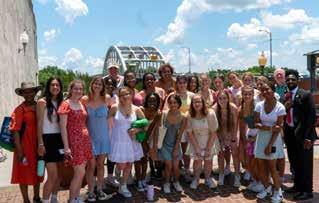The Heart of the Civil Rights Movement
In early June, 20 students and six faculty and staff members traveled south for Visitation’s inaugural school trip to study the United States’ Civil Rights movement. The trip to Georgia and Alabama included visits to landmarks students learn about in history class and museums about Civil Rights. Four students who made the journey shared reflections on their experiences.

Day 3, June 1
The Legacy Museum: From Mass Enslavement to Mass Incarceration

Today was by far the heaviest day of the trip. We visited four museums; the first two were very upsetting, but fantastic and informative. The Legacy Museum, created by Bryan Stevenson, is by far the best museum I’ve ever been to. I cried within the first ten minutes; it was very well executed, but very jarring. A mixture of art installations, interactive activities, and countless shocking facts and stories left nothing uncovered, and was just blunt enough to make you rightfully uncomfortable and angry about the shameful history it covered.
Later in the day, we went to the memorial for all the victims of lynching in the U.S. Beginning during slavery, lynching was a common hate crime that ocurred to a shocking degree all over the country. I had not a clue how many people died by lynching in the U.S. Even northern states had dozens of names and dates memorializing victims. The memorial definitely stuck with me the most out of everything on the trip; its design and message were intensely effective and I’m glad I got to see it, even if it made me sick to my stomach.
All the historical comparisons to today that I saw within the museums were very upsetting. It makes me angry that there hasn’t been change sufficient to see a true contrast from the civil rights
movement to things that happen today. Seeing police brutality and racism continue today when people have taken such strides to end it is frustrating beyond belief. I hope we can continue to work towards making that change once and for all
Day 3, June 1

National Memorial for Peace and Justice
Today we visited the National Memorial for Peace and Justice, a museum actualized by Bryan Stevenson and the Equal Justice Inititive to honor the thousands of victims of lynchings in this country. I had seen pictures and videos of this remarkable museum before, but nothing compared to witnessing it in person.
KAEDEN ’23
The main feature of the memorial is 805 hanging steel rectangles, each one representing a U.S. county where a documented lynching took place. Every rectangle had the names of the lynching victims etched on the front, remembering those innocent lives horrifically murdered. Some blocks only had one name written; some had twenty or more; others did not have names at all, but instead listed “unknowns.” Walking through the memorial, I tried to sound out every name in my head, as if by thinking of these people, their lives would live on. I quickly realized that there were just too many blocks…too many names…too many lynchings.
My friend and I then noticed that some of the blocks contained ten or more names of those who had been lynched on the same day. When we asked our tour guide about this, he told us that those people died in massacres—in instances when a large number of African Americans were killed together. At the end of the memorial, there were plaques containing factual stories of lynchings. I learned that sometimes when the murderers could not find the person that they were looking for, they would kill one of their family members instead or sometimes even the closest African American they could find. I learned that the ages of the victims did not matter; they lynched children too. I learned that you could also be lynched for merely saying “hi” to a white woman as she walked down the street. Lastly, I learned—or more like felt viscerally—the deep wounds of our country. The scars are still there. We have a lot more healing and reconciliation to do.





